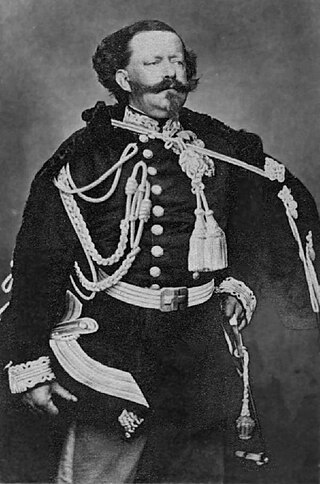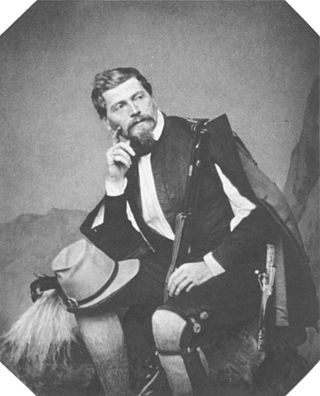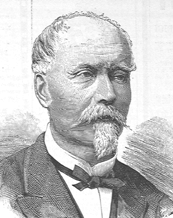
Albert was King of Saxony from 29 October 1873 until his death in 1902.

Victor Emmanuel II was King of Sardinia from 23 March 1849 until 17 March 1861, when he assumed the title of King of Italy and became the first king of an independent, united Italy since the 6th century, a title he held until his death in 1878. Borrowing from the old Latin title Pater Patriae of the Roman emperors, the Italians gave him the epithet of "Father of the Fatherland".

William I, or Wilhelm I, was King of Prussia from 1861 and German Emperor from 1871 until his death in 1888. A member of the House of Hohenzollern, he was the first head of state of a united Germany. He was de facto head of state of Prussia from 1858, when he became regent for his brother Frederick William IV. During the reign of his grandson Wilhelm II, he was known as Wilhelm the Great.

Ludwig Samson Heinrich Arthur Freiherr von und zu der Tann-Rathsamhausen was a Bavarian general.

Johann Josef Wenzel Anton Franz Karl, Graf Radetzky von Radetz was a Czech nobleman and Austrian field marshal. He served as chief of the general staff in the Habsburg monarchy during the later period of the Napoleonic Wars and proved instrumental in the allied victory as one of the primary architects of the Trachenberg Plan and the Leipzig Campaign. Afterwards, he embarked on military reforms of the Austrian army. His reputation was one of discipline and fairness; he was revered by his troops among whom he was known as Vater ('Father') Radetzky. He is best known for the victories at the Battles of Custoza and Novara during the First Italian War of Independence. Johann Strauss I's Radetzky March was commissioned to commemorate Radetzky's victories at the Battle of Custoza.

Albrecht Theodor Emil Graf von Roon was a Prussian soldier and statesman. As Minister of War from 1859 to 1873, Roon, along with Otto von Bismarck and Helmuth von Moltke, was a dominating figure in Prussia's government during the key decade of the 1860s, when a series of successful wars against Denmark, Austria, and France led to German unification under Prussia's leadership. A moderate conservative and supporter of executive monarchy, he was an avid modernizer who worked to improve the efficiency of the army.

Prince Leopold of Bavaria was born in Munich, the second son of Prince Regent Luitpold of Bavaria (1821–1912) and his wife Archduchess Augusta of Austria (1825–1864). He was a Field Marshal (Generalfeldmarschall) who commanded German and Austro-Hungarian forces on the Eastern Front in World War I.

Adrian Friedrich Wilhelm Julius Ludwig von Verdy du Vernois, often given the short name of Verdy, was a German general and staff officer, chiefly noted both for his military writings and his service on Helmuth von Moltke the Elder's staff during the Franco-Prussian War.

Duke William of Württemberg was an Austrian and Württemberg General.

Karl Konstantin Albrecht Leonhard Graf von Blumenthal was an officer of the Prussian Army and field marshal of the Imperial German Army, chiefly remembered for his decisive intervention at the Battle of Königgrätz in 1866, his victories at Wörth and Weißenburg, and above all his refusal to bombard Paris in 1870 during the siege, of which he was in command.

Antonio Starrabba, Marquess of Rudinì was an Italian statesman, Prime Minister of Italy between 1891 and 1892 and from 1896 until 1898.

Ferdinand IV, Grand Duke of Tuscany was the last Grand Duke of Tuscany from 1859 to 1860.

Kraft Prinz zu Hohenlohe-Ingelfingen was a Prussian general and military writer during the time of the German Empire.

Harald Nicolai Storm Wergeland was a Norwegian military officer, politician and mountaineer. Having reached the rank of major general by 1859, he served as Minister of the Army for several periods between 1857 and 1868. He later became lieutenant general. He had several notable family members.

Count Illarion Ivanovich Vorontsov-Dashkov was a notable representative of the Vorontsov family. He served as Minister of Imperial Properties in 1881-97 and the Governor-General of the Caucasus Viceroyalty between 1905 and 1915.

Umberto I was King of Italy from 9 January 1878 until his assassination in 1900. His reign saw Italy's expansion into the Horn of Africa, as well as the creation of the Triple Alliance among Italy, Germany and Austria-Hungary.

Heinrich Hermann Josef Freiherr von Heß, was an Austrian soldier and field marshal, who entered the army in 1805 and was soon employed as a staff officer on survey work.

Alessandro Asinari di San Marzano (1830–1906) was an Italian politician, general, and Senator of the Kingdom of Italy

Karl, Prince of Wedel, born Karl Leo Julius Graf von Wedel, was a Prussian general and diplomat who served as the fourth Imperial Lieutenant of the Reichsland of Alsace–Lorraine from 27 October 1907 until his resignation on 18 April 1914.

Emilio Maurizio Ferrero was an Italian politician and general. He was a senator of the Kingdom of Italy in the 14th legislature. He served as Minister of War of the Kingdom of Italy in the third Cairoli government and in the fourth, fifth and sixth Depretis governments.




















